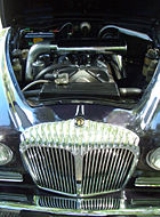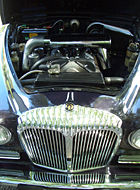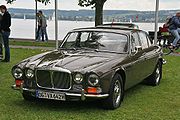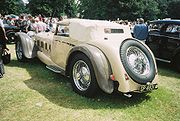
Daimler Sovereign
Encyclopedia
Daimler Sovereign was a name applied by British manufacturer Jaguar Cars to a sequence of luxury automobile
s built by it but carrying the Daimler badge between 1966 and 1983.
The Daimler Sovereigns were based on contemporary Jaguar bodyshells, chassis and engines in an early example of badge engineering
. Jaguar Cars took over the Daimler
company in 1960 and the 1966 Sovereign was the second Daimler
to be based on a Jaguar model. The first was the 2½ litre V8
with a V8 engine designed by Edward Turner
. Unlike the Daimler 2½ litre, the Sovereign had a Jaguar engine, marking the end for the Turner designed engines.
The first Daimler Sovereign was based on the 1966 Jaguar 420 and is sometimes referred to as the "Sovereign 420". Subsequent Sovereigns arose from the Series I, II and III Jaguar XJ6. In 1983 the model name "Sovereign" was switched to the high specification version of the Series III Jaguar XJ6, the 6-cylinder Daimler based on it simply continuing without a model name. The V12 versions of the Daimler, available from 1972 to 1997, were known as the Daimler Double-Six.
 The first Sovereign
The first Sovereign
was a badge-engineered version of the Jaguar 420
saloon, which was itself based on the Jaguar S-Type
.
The 420 and Sovereign differed from the S-Type in having a revised four-headlight nose reminiscent of the Jaguar Mark X
and a 4.2 litre version of the straight-six XK engine
. The main external difference between the 420 and Sovereign was the traditional Daimler fluted radiator grille. More detail of the development of the 420/Sovereign and the ways in which the Sovereign differed from its Jaguar stablemate can be found in the article on the Jaguar 420 and Daimler Sovereign
.
There were thoughts of fitting the Sovereign with the Daimler 4½ litre V8 engine
as used in the Majestic Major
but as this significantly outperformed the Jaguar XK unit and would have led to the Sovereign outgunning the Jaguar 420 the Jaguar hierarchy did not pursue the idea; the Jaguar marque was supposed to be more sporty than the Daimler.
In 1967 the final drive ratio was quietly changed from 3.31:1 to 3.54:1 which led to press complaints about fussier high speed cruising but which improved acceleration times from stand-still within the range of the speeds legal in Britain following the introduction, in December 1965, of a blanket 70 mph (113 km/h) speed limit
across the nation's highways.
The front-end styling of the Daimler DS420
limousine introduced in 1968 shared a family resemblance with a Daimler grille mated to a four headlight nose.
The 420/Sovereign range began to be replaced by the Jaguar XJ6 in September 1968. The Jaguar ceased production in December 1968, the Daimler remaining in production until July 1969.

.
designation; in some markets where there were licensing problems in the use of the Daimler name, cars with the Daimler fluted grille were sold as Jaguar Vanden Plas.
 From 1972 Jaguar's 5.3 litre V12
From 1972 Jaguar's 5.3 litre V12
engine was available in the XJ range, and for the Daimler version a name used by the company from 1926 to 1938 was revived. Sir William Lyons had retired from Jaguar in 1972 and the new chairman was FRW (Lofty) England
. Lofty England had been a Daimler apprentice from 1927 to 1932 and taken second place in the first ever RAC rally driving a 30/40 hp Daimler double-six. Lofty England decreed that the new V12 Daimler would be known as Double Six.
Unlike the Jaguar, the twelve-cylinder Daimler had the same radiator grill as its six-cylinder sibling, and externally only the badges distinguished them. Although the Sovereign name was transferred to Jaguar, the Double Six name remained with Daimler throughout Series III production, which continued until 1992.
When Jaguar re-engineered the XJ40 to take a 6.0 litre version of the V12 engine, under the model designation XJ81, a new Double Six was also produced, being manufactured between 1993 and 1994. In the latter year, along with the other XJ models, it was facelifted under the X305 designation and continued to be produced until the V12 engine was dropped in 1997.
Photos of the three series of Sovereign XJ models on the Daimler home page :
Automobile
An automobile, autocar, motor car or car is a wheeled motor vehicle used for transporting passengers, which also carries its own engine or motor...
s built by it but carrying the Daimler badge between 1966 and 1983.
The Daimler Sovereigns were based on contemporary Jaguar bodyshells, chassis and engines in an early example of badge engineering
Badge engineering
Badge engineering is an ironic term that describes the rebadging of one product as another...
. Jaguar Cars took over the Daimler
Daimler Motor Company
The Daimler Motor Company Limited was an independent British motor vehicle manufacturer founded in London by H J Lawson in 1896, which set up its manufacturing base in Coventry. The right to the use of the name Daimler had been purchased simultaneously from Gottlieb Daimler and Daimler Motoren...
company in 1960 and the 1966 Sovereign was the second Daimler
Daimler Motor Company
The Daimler Motor Company Limited was an independent British motor vehicle manufacturer founded in London by H J Lawson in 1896, which set up its manufacturing base in Coventry. The right to the use of the name Daimler had been purchased simultaneously from Gottlieb Daimler and Daimler Motoren...
to be based on a Jaguar model. The first was the 2½ litre V8
Daimler 250
The 2.5-V8/V8-250 was the last Daimler car to feature a Daimler engine after the marque was acquired by Jaguar Cars in 1960. The engine is the hemispherical head V8 designed by Edward Turner and first used in the Daimler SP250 sports car.-Daimler 2.5-V8:...
with a V8 engine designed by Edward Turner
Edward Turner
Edward Turner was a British motorcycle designer. He was born in Camberwell in the London Borough of Southwark, on the day King Edward VII was proclaimed King....
. Unlike the Daimler 2½ litre, the Sovereign had a Jaguar engine, marking the end for the Turner designed engines.
The first Daimler Sovereign was based on the 1966 Jaguar 420 and is sometimes referred to as the "Sovereign 420". Subsequent Sovereigns arose from the Series I, II and III Jaguar XJ6. In 1983 the model name "Sovereign" was switched to the high specification version of the Series III Jaguar XJ6, the 6-cylinder Daimler based on it simply continuing without a model name. The V12 versions of the Daimler, available from 1972 to 1997, were known as the Daimler Double-Six.
Sovereign 420

Jaguar 420 and Daimler Sovereign (1966–69)
The Jaguar 420 and its Daimler Sovereign equivalent were introduced at the October 1966 London Motor Show and produced for two years as the ultimate expression of a series of "compact sporting saloons" offered by Jaguar throughout that decade, all of which shared the same wheelbase...
was a badge-engineered version of the Jaguar 420
Jaguar 420 and Daimler Sovereign (1966–69)
The Jaguar 420 and its Daimler Sovereign equivalent were introduced at the October 1966 London Motor Show and produced for two years as the ultimate expression of a series of "compact sporting saloons" offered by Jaguar throughout that decade, all of which shared the same wheelbase...
saloon, which was itself based on the Jaguar S-Type
Jaguar S-Type (1963)
The Jaguar S-Type was produced from 1963–68 as a technically more sophisticated development of the Jaguar Mark 2, offering buyers a more luxurious alternative to the Mark 2 without the size and expense of the Mark X. It sold alongside the Mark 2, as well as the Jaguar 420 following its release in...
.
The 420 and Sovereign differed from the S-Type in having a revised four-headlight nose reminiscent of the Jaguar Mark X
Jaguar Mark X
The Jaguar Mark X was the top-of-the-range saloon car built by the British manufacturer Jaguar, originally aimed at the United States market. The Mark X succeeded the Mark IX as the company's large saloon model.-Body:...
and a 4.2 litre version of the straight-six XK engine
Jaguar XK6 engine
The renowned Jaguar XK dual overhead camshaft inline 6-cylinder engine was introduced in 1949 and continued in manufacture until 1992. It was produced in five displacements for Jaguar passenger cars, with other sizes being made by Jaguar and privateers for racing...
. The main external difference between the 420 and Sovereign was the traditional Daimler fluted radiator grille. More detail of the development of the 420/Sovereign and the ways in which the Sovereign differed from its Jaguar stablemate can be found in the article on the Jaguar 420 and Daimler Sovereign
Jaguar 420 and Daimler Sovereign (1966–69)
The Jaguar 420 and its Daimler Sovereign equivalent were introduced at the October 1966 London Motor Show and produced for two years as the ultimate expression of a series of "compact sporting saloons" offered by Jaguar throughout that decade, all of which shared the same wheelbase...
.
There were thoughts of fitting the Sovereign with the Daimler 4½ litre V8 engine
Daimler 2.5 & 4.5 litre
The Daimler 2.5 & 4.5 litre V-8 engines were designed by Edward Turner in 1959 and used in several of the cars made by the British Daimler company in the 1950s and 1960s...
as used in the Majestic Major
Daimler Majestic Major
The Daimler Majestic Major was a large executive saloon made by Daimler in Coventry between 1959 and 1968, using a 4,561 cc V8 engine and offered as a much more powerful supplement to their then current Daimler Majestic....
but as this significantly outperformed the Jaguar XK unit and would have led to the Sovereign outgunning the Jaguar 420 the Jaguar hierarchy did not pursue the idea; the Jaguar marque was supposed to be more sporty than the Daimler.
In 1967 the final drive ratio was quietly changed from 3.31:1 to 3.54:1 which led to press complaints about fussier high speed cruising but which improved acceleration times from stand-still within the range of the speeds legal in Britain following the introduction, in December 1965, of a blanket 70 mph (113 km/h) speed limit
Tom Fraser
Tom Fraser PC was a Labour Member of Parliament for the Hamilton constituency between 1943 and 1967.He was Minister of Transport from October 16, 1964 until December 23, 1965...
across the nation's highways.
The front-end styling of the Daimler DS420
Daimler DS420
The Daimler DS420, popularly known as the Daimler Limousine, is a large limousine produced by Daimler Motor Company between 1968 and 1992. The vehicles are used extensively as official state cars in several countries, including by the British and Danish Royal Families...
limousine introduced in 1968 shared a family resemblance with a Daimler grille mated to a four headlight nose.
The 420/Sovereign range began to be replaced by the Jaguar XJ6 in September 1968. The Jaguar ceased production in December 1968, the Daimler remaining in production until July 1969.
Sovereign XJ6

Series I
A new Series I XJ6-based Sovereign was introduced in October 1969. Once again, it was externally virtually identical to its Jaguar source car with the exception of its fluted grille and Daimler badging. Internally there were trim variations, such as the deletion of the wood door cappings fitted to the Jaguar. This Sovereign was offered with either the 2.8 litre or the 4.2 litre version of the XK engineJaguar XK6 engine
The renowned Jaguar XK dual overhead camshaft inline 6-cylinder engine was introduced in 1949 and continued in manufacture until 1992. It was produced in five displacements for Jaguar passenger cars, with other sizes being made by Jaguar and privateers for racing...
.
Series II
The Daimler Sovereign name remained in use for the Series II version of the XJ6, with a raised front bumper and shallower grille; an extended wheelbase version was introduced, which eventually became the standard model. From 1975 the 2.8 litre was replaced by a 3.4 litre version of the XK engine.Series III
The Series III XJ6 range which appeared in 1979 was visually distinguished from the Series II by its new thicker bumpers, the removal of separate "quarter-light" windows from the front doors, and a revised rear roofline featuring a slightly more angular c-pillar. The Series III range initially continued to include a Daimler Sovereign, but in 1983, during the run of the Series III, the range was re-named with the base model named the Jaguar XJ6, the more luxurious version named the Jaguar Sovereign, and the top-of-the-range simply known as the Daimler, without a model name. Some top-of-the-range versions were given the Vanden PlasVanden Plas
Vanden Plas is the name of a company of coachbuilders who produced bodies for specialist and up-market automobile manufacturers. Latterly the name became a top-end luxury model designation for cars from various subsidiaries of British Leyland and the Rover Group.-Belgium:It originated in Belgium in...
designation; in some markets where there were licensing problems in the use of the Daimler name, cars with the Daimler fluted grille were sold as Jaguar Vanden Plas.
Sovereign Coupé
Jaguar introduced a short-lived two-door pillarless coupé version of the Series II using the short wheelbase floorpan and Daimler versions using both six and twelve cylinder engines were also available.Daimler Double Six

Jaguar V12 engine
Jaguar V12 piston engine was one of the premier powerplants of the 1970s and 1980s. It was first seen in the Series 3 Jaguar E-type of 1971 and was based loosely on an earlier design intended for a Le Mans car, the ill-fated Jaguar XJ13. The V12 was only Jaguar's second engine design to go into...
engine was available in the XJ range, and for the Daimler version a name used by the company from 1926 to 1938 was revived. Sir William Lyons had retired from Jaguar in 1972 and the new chairman was FRW (Lofty) England
Lofty England
Frank Raymond Wilton "Lofty" England was an engineer and motor company manager from England. He rose to fame as the manager of the Jaguar Cars sports car racing team in the 1950s, during which time Jaguar cars won the prestigious 24 Hours of Le Mans race on five occasions...
. Lofty England had been a Daimler apprentice from 1927 to 1932 and taken second place in the first ever RAC rally driving a 30/40 hp Daimler double-six. Lofty England decreed that the new V12 Daimler would be known as Double Six.
Unlike the Jaguar, the twelve-cylinder Daimler had the same radiator grill as its six-cylinder sibling, and externally only the badges distinguished them. Although the Sovereign name was transferred to Jaguar, the Double Six name remained with Daimler throughout Series III production, which continued until 1992.
When Jaguar re-engineered the XJ40 to take a 6.0 litre version of the V12 engine, under the model designation XJ81, a new Double Six was also produced, being manufactured between 1993 and 1994. In the latter year, along with the other XJ models, it was facelifted under the X305 designation and continued to be produced until the V12 engine was dropped in 1997.
Scale models
- The Daimler Sovereign XJ6 Series 1 has been modelled by Lledo VanguardsCorgi Classics LimitedCorgi Classics Limited is a die-cast model manufacturer which has its origins in the Corgi Toys brand introduced by Mettoy in 1956.-The Corgi Toys era: 1956 to 1995:...
in the 2000s. - Neo Scale Models have produced a 1:43 resin molded model of the Daimler XJ6 Series III Vanden Plas.
External links
Photo of the original Sovereign on the Jaguar database :Photos of the three series of Sovereign XJ models on the Daimler home page :

